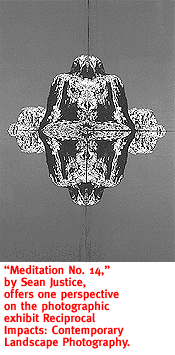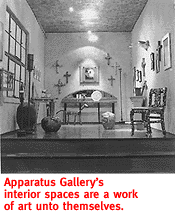 |

The Lost Apparatus Celebrates Its First Anniversary In The Lost Barrio.
By Mari Wadsworth
THERE'S AN EXTENSION of the Downtown Arts District that's
slipped through the cracks: the Lost Barrio Warehouse District
on South Park Avenue and Broadway. Zoned for commercial, residential
and industrial use, it's an odd grouping of buildings and purposes
arguably providing one of the finest examples of urban living
in the Old Pueblo. As yet it remains a quiet street, marked by
brightly painted storefronts, metal roofs, hand-crafted signs,
unlikely blooms of potted plants, and the raw materials of commercial
works-in-progress.
A variety of retail shops specializing in furniture and home
furnishings, each as individual as its neighborhood context, have
filled in the west side of the street; and the near-complete Project
M.O.R.E. High School, already an award-winning architectural feather
in our civic cap, is a promise of more good things to come. Also,
South Park is the focus of a UA School of Architecture design
studio project, which, hopefully, will address the woeful lack
of parking in the area.
But the real gem remains the 1,200-square-foot space local artist
Sharon Holnback has converted into the Apparatus Gallery. Holnback,
whose background is photography, rented the space at 299 S. Park
Avenue four years ago as her working studio. Three years later,
she looked around at what she sheepishly describes as a disorganized
mess of materials and projects in various stages of completion
and determined it was time to move into a new era.
"I was interested in creating an area of display for my
own work," she says. "My background is in photography,
but I enjoy working with a variety of materials," a fact
evidenced by her numerous collaborations with other locals. She's
currently working with sculptor Dante Fraboni (who shares the
studio space in the rear of the gallery for his sandblasted flagstone
creations) on a series of "yardworks" fabricated from
cut steel and colored glass. "(The gallery) was a natural
evolution," Holnback says. "There were so many local
artists doing interesting work, I decided to incorporate that
talent."
 The gallery is set back a few paces from the street as part of
the Elan Building, which the gallery shares with a real estate
office and Tooley's Café. Holnback has taken advantage
of the north-facing sidewalk space to create a garden to showcase
some of her recent innovations with patina-finished steel. She
also redesigned the warehouse's interior space. Just like the
artists she showcases, Holnback has invoked a stunning use of
humble materials to give the space a character that is at once
homey and artistic while maintaining its industrial edge. The
warehouse shell has been carved up by eight-foot interior walls,
but the trusses of its high ceilings remain exposed. Woven mats
(for sale) soften its concrete floors. "This was just a concrete
pad," she says, gesturing to what is now a sort of shrine
to functional art that draws you in immediately from the warehouse's
yellow wooden stable doors.
The gallery is set back a few paces from the street as part of
the Elan Building, which the gallery shares with a real estate
office and Tooley's Café. Holnback has taken advantage
of the north-facing sidewalk space to create a garden to showcase
some of her recent innovations with patina-finished steel. She
also redesigned the warehouse's interior space. Just like the
artists she showcases, Holnback has invoked a stunning use of
humble materials to give the space a character that is at once
homey and artistic while maintaining its industrial edge. The
warehouse shell has been carved up by eight-foot interior walls,
but the trusses of its high ceilings remain exposed. Woven mats
(for sale) soften its concrete floors. "This was just a concrete
pad," she says, gesturing to what is now a sort of shrine
to functional art that draws you in immediately from the warehouse's
yellow wooden stable doors.
The floor consists of 2-by-2-foot plates of steel, distressed
to a deep, rusty brown and varnished, fastened to the ground with
screws. The brick walls have been textured and faux painted in
thick, swirling coats of yellow and peach. The ceiling is painted
aluminum (foil, that is). Rice paper screens out the security
bars on factory windows, while still letting in an abundance of
natural light. A low-voltage halogen track lighting system, with
fixtures by Scott Madden, consists of copper tubes and funnel
shapes dangling like mobile pieces from a pair of cables running
the length of the ceiling. The space itself is a work of art,
and a perfect setting for an array of found-object furniture (Cornelius
and Donovan), metal sculpture (Ned Egan), forged-steel mosaic
tables (Rocky Dobosz), ceramic wall hangings (David Aguirre) and
various vases, vessels and glassware (Andy Iventosh, Daniels'
Anvil and It's A Blast).
IN ADDITION TO this regular assortment of fine and functional
art by more than 30 local artists, covering the spectrum from
cards and jewelry to furniture and garden elements, the gallery
also features a space for curated shows. The current exhibit of
photography, entitled Reciprocal Impacts: Contemporary Landscape
Photography, shares the gallery's (and Holnback's) affinity for
extracting the extraordinary from the ordinary. Described as "the
physical impact of humans upon the landscape (and) the spiritual
impact of the landscape on humans," the show consists of
25 pieces by seven local artists, covering a broad range of technique
and perspective. The show was the brainchild of current Group
for Photographic Intentions president Barry Baldridge, and five
of the seven participating artists are group members.
 Although the works stand up well on their individual merits,
the real success of the show is in the curation: from the stark
realism of Larry Wilson's Infrastructure series, black-and-white
toned silver prints of Pusch Ridge and East Broadway in the early
stages of development, to Thomas Grubba's hand-applied, hand-colored
creations more reminiscent of watercolors than photographs, framed
in weathered, found wood pieces. Taken as a whole, the carefully
chosen body of works captures the modern and the timeless, contrasting
the beauty--and degradation--that emerges from the collision between
the man-made and natural worlds.
Although the works stand up well on their individual merits,
the real success of the show is in the curation: from the stark
realism of Larry Wilson's Infrastructure series, black-and-white
toned silver prints of Pusch Ridge and East Broadway in the early
stages of development, to Thomas Grubba's hand-applied, hand-colored
creations more reminiscent of watercolors than photographs, framed
in weathered, found wood pieces. Taken as a whole, the carefully
chosen body of works captures the modern and the timeless, contrasting
the beauty--and degradation--that emerges from the collision between
the man-made and natural worlds.
Take "Navajo," one of J. Keith Schreiber's labor-intensive
palladium contact prints, in which distant smoke stacks rise up
to meet endless powerlines on a vast desert plain. Right next
to them, Sean Justice's Cibachrome color prints juxtapose cut
negatives of mountains into kaleidoscopic photo collages against
a regal blue background. Although the images are taken from the
natural world, to my eye they look like still lifes of man-made
objects: the mirrored reflection of Tucson mountains in "Meditation
No. 14" looks like a photograph of a museum piece (a jeweled
crown? a sculpture?), while "Meditation No. 7," from
a distance, might be an ornate architectural detail. On the adjacent
wall, Amey Broeker and Greg Huston's contact prints on gold-toned
paper are warm, coppery reflections on decaying architectural
elements imposed on the landscape.
Nearby, David M. Elliot's silver prints of urban hardscapes offer
a surrealist view in which the landscape is treated as an object,
from the shopping mall viewpoint in "Las Vegas" to the
looming, panoramic perspective of "Power Object."
It's a thought-provoking assemblage of works, with as many possible
interpretations as there are variations in the landscape. In an
interesting departure, for example, Thomas Grubba's mixed-media
"A Moment Before Twilight" takes an unspoiled landscape
and distorts it. Gloopy, yellowish epoxy drips and cracks and
distorts a chemically manipulated gelatin silver print of a dark,
shadowy forest of saguaro and cholla. It's an eerie and somewhat
foreboding image, and an ominous conclusion to the contemplative
reflections on the fabric of our existence.
Reciprocal Impacts: Contemporary Landscape Photography,
works by Amey Broeker, Greg Huston, David Elliot, Thomas Grubba,
Sean Justice, Larry Wilson and J. Keith Schreiber, continues through
April 27 at Apparatus Gallery, 299 S. Park Ave. Regular gallery
hours are 10:30 a.m. to 5 p.m. Tuesday through Saturday. Call
791-3505 for information.

|
 |
